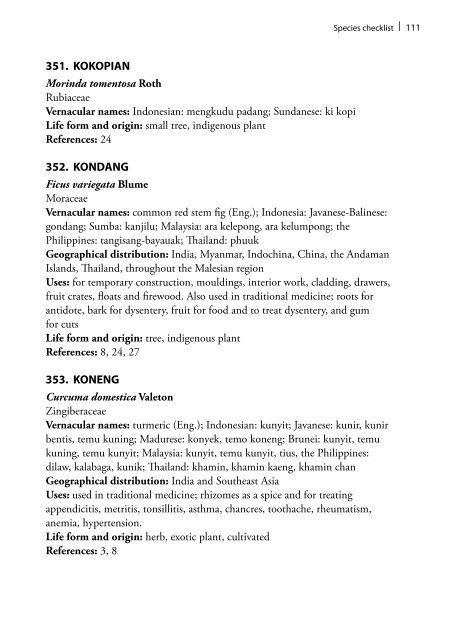Five hundred plant species in gunung Halimun Salak ... - CIFOR
Five hundred plant species in gunung Halimun Salak ... - CIFOR
Five hundred plant species in gunung Halimun Salak ... - CIFOR
Create successful ePaper yourself
Turn your PDF publications into a flip-book with our unique Google optimized e-Paper software.
351. KOKOPIAN<br />
Mor<strong>in</strong>da tomentosa Roth<br />
Rubiaceae<br />
Vernacular names: Indonesian: mengkudu padang; Sundanese: ki kopi<br />
Life form and orig<strong>in</strong>: small tree, <strong>in</strong>digenous <strong>plant</strong><br />
References: 24<br />
Species checklist | 111<br />
352. KONDANG<br />
Ficus variegata Blume<br />
Moraceae<br />
Vernacular names: common red stem fig (Eng.); Indonesia: Javanese-Bal<strong>in</strong>ese:<br />
gondang; Sumba: kanjilu; Malaysia: ara kelepong, ara kelumpong; the<br />
Philipp<strong>in</strong>es: tangisang-bayauak; Thailand: phuuk<br />
Geographical distribution: India, Myanmar, Indoch<strong>in</strong>a, Ch<strong>in</strong>a, the Andaman<br />
Islands, Thailand, throughout the Malesian region<br />
Uses: for temporary construction, mould<strong>in</strong>gs, <strong>in</strong>terior work, cladd<strong>in</strong>g, drawers,<br />
fruit crates, floats and firewood. Also used <strong>in</strong> traditional medic<strong>in</strong>e; roots for<br />
antidote, bark for dysentery, fruit for food and to treat dysentery, and gum<br />
for cuts<br />
Life form and orig<strong>in</strong>: tree, <strong>in</strong>digenous <strong>plant</strong><br />
References: 8, 24, 27<br />
353. KONENG<br />
Curcuma domestica Valeton<br />
Z<strong>in</strong>giberaceae<br />
Vernacular names: turmeric (Eng.); Indonesian: kunyit; Javanese: kunir, kunir<br />
bentis, temu kun<strong>in</strong>g; Madurese: konyek, temo koneng; Brunei: kunyit, temu<br />
kun<strong>in</strong>g, temu kunyit; Malaysia: kunyit, temu kunyit, tius, the Philipp<strong>in</strong>es:<br />
dilaw, kalabaga, kunik; Thailand: kham<strong>in</strong>, kham<strong>in</strong> kaeng, kham<strong>in</strong> chan<br />
Geographical distribution: India and Southeast Asia<br />
Uses: used <strong>in</strong> traditional medic<strong>in</strong>e; rhizomes as a spice and for treat<strong>in</strong>g<br />
appendicitis, metritis, tonsillitis, asthma, chancres, toothache, rheumatism,<br />
anemia, hypertension.<br />
Life form and orig<strong>in</strong>: herb, exotic <strong>plant</strong>, cultivated<br />
References: 3, 8

















